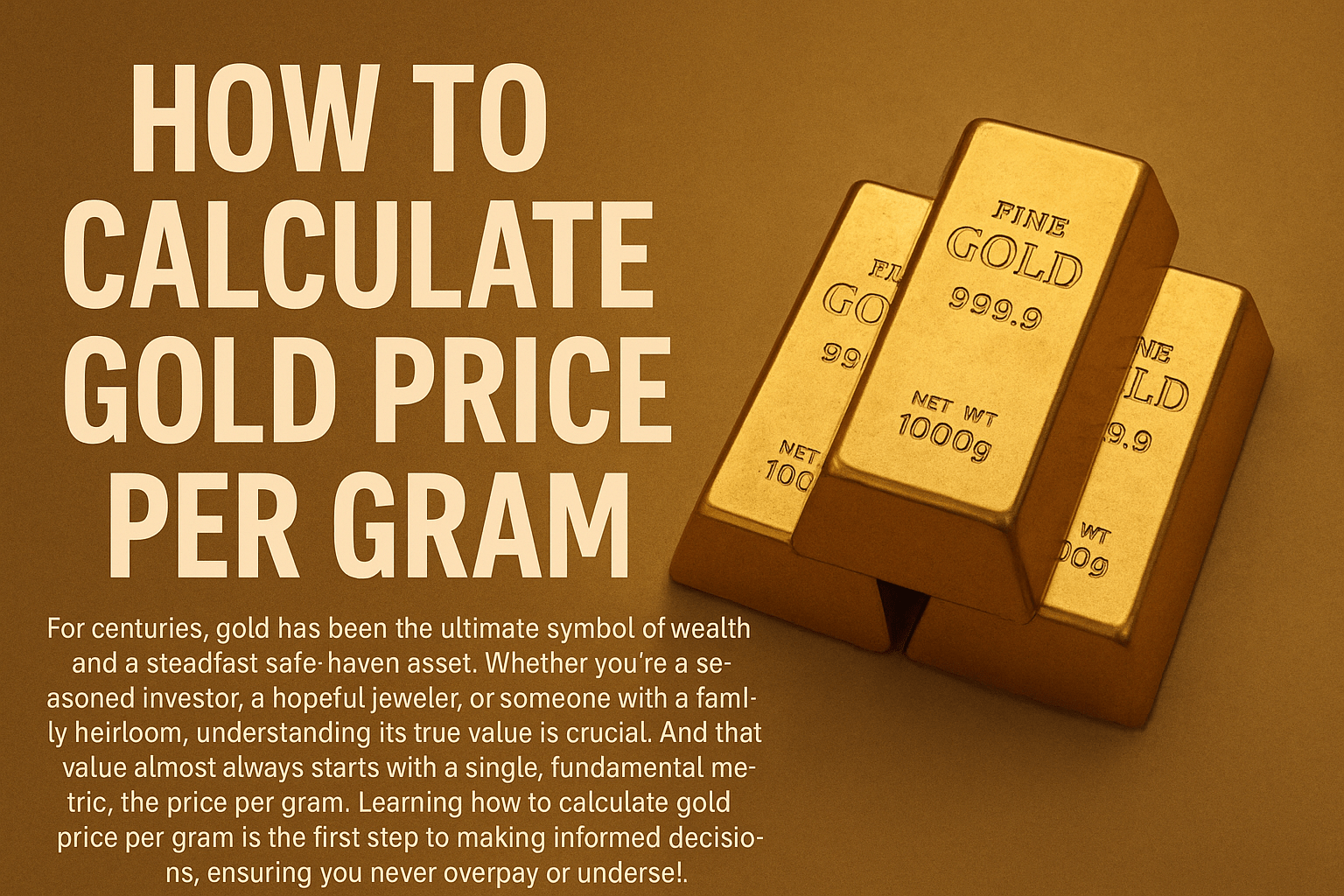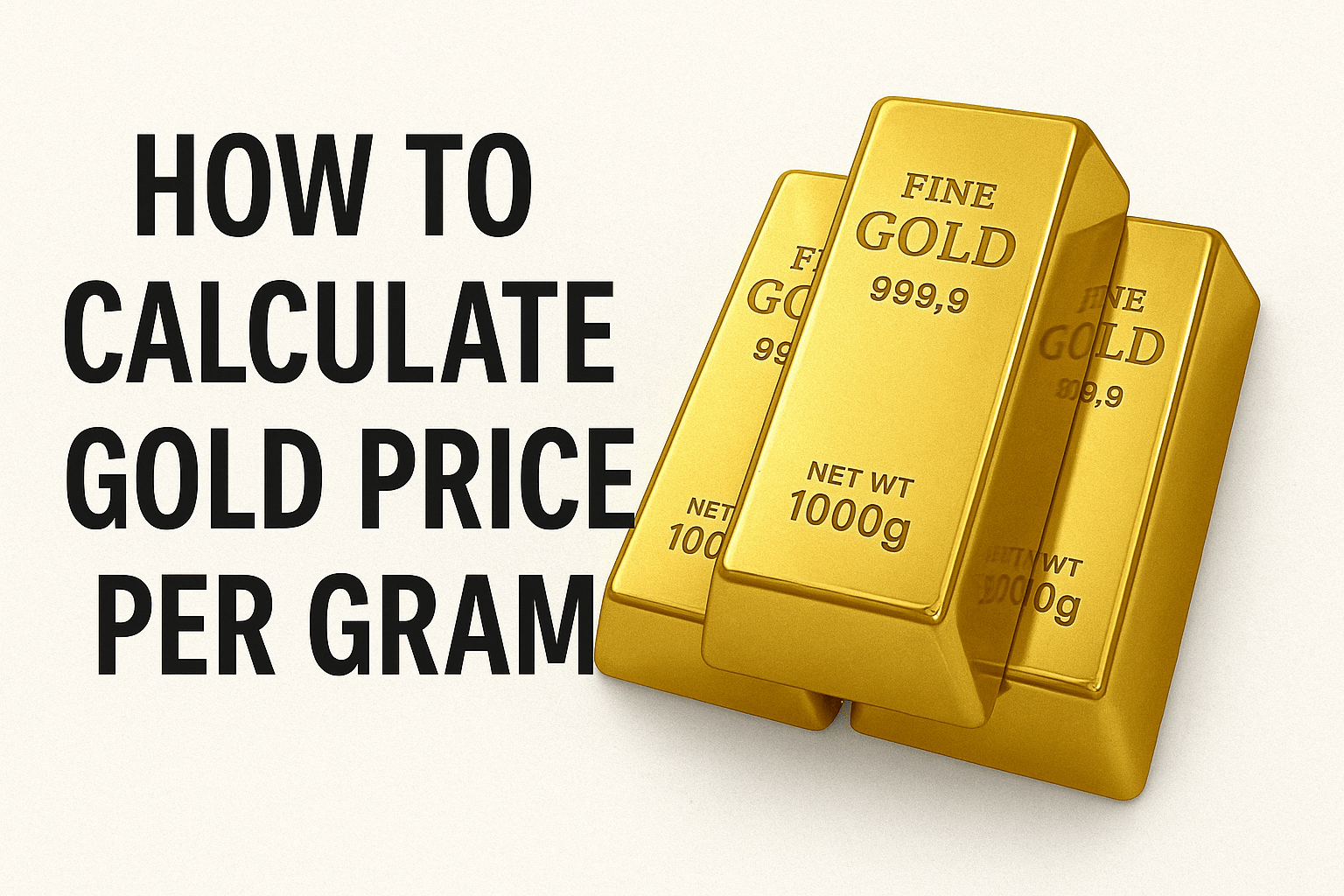Gold. For centuries, it has been the ultimate symbol of (Calculate Gold Price Per Gram) wealth and a steadfast safe-haven asset. Whether you’re a seasoned investor, a hopeful jeweler, or someone with a family heirloom, understanding its true value is crucial. And that value almost always starts with a single, fundamental metric: the price per gram. Learning how to calculate gold price per gram is the first step to making informed decisions, ensuring you never overpay or undersell. This comprehensive guide will demystify the entire process, from global market rates to the final price of your piece.
The Foundation: Understanding the Gold Spot Price
Before you can calculate gold price per gram, you must understand its source. The spot price is the absolute bedrock of all gold valuation. It’s the current market price for one troy ounce of pure (99.99% fine) gold for immediate delivery. This price is set by global commodities exchanges like the COMEX in New York or the LBMA in London, and it fluctuates constantly based on a complex dance of factors:
-
Global Supply and Demand: Mining output, central bank buying/selling, and industrial demand.
-
Economic Data: Inflation rates, interest rates, and employment figures.
-
Geopolitical Events: Wars, elections, and international tensions drive investors toward safe havens.
-
U.S. Dollar Strength: Since gold is dollar-denominated, a weaker dollar often makes gold cheaper for other currencies, driving its price up.
You can find the live spot price on financial news websites like Bloomberg or Kitco, or simply by searching “gold spot price” on Google.
https://www.kitco.com/LFgif/au24.gif
Image Alt Text: Live gold spot price chart to calculate gold price per gram
Converting Troy Ounces to Grams
Here’s our first calculation. The spot price is per troy ounce, but we need it per gram. A troy ounce is not the same as a standard (avoirdupois) ounce used in cooking.
-
1 Troy Ounce = 31.1034768 Grams
For simplicity, most calculators use 31.1035 grams.
The Formula:
Gold Price Per Gram (Pure) = Gold Spot Price / 31.1035
Example: If the gold spot price is $2,000 per troy ounce.
$2,000 / 31.1035 = $64.30 per gram
This $64.30 is the baseline value for one gram of 24-karat pure gold.

The Crucial Factor: Gold Purity and Karats
Not all gold is pure. In jewelry and even some coins, gold is alloyed with other metals like silver, copper, or zinc to increase durability and change color. This is where karats come in. Karat (kt) is a measure of gold purity, with 24 karats being 100% pure gold.
The purity is a direct multiplier in our calculation.
| Karat | Purity (Percentage) | Purity (Decimal) |
|---|---|---|
| 24kt | 99.9% Pure Gold | 0.999 |
| 22kt | 91.6% Pure Gold | 0.916 |
| 18kt | 75.0% Pure Gold | 0.750 |
| 14kt | 58.3% Pure Gold | 0.583 |
| 10kt | 41.7% Pure Gold | 0.417 |
The Formula:
Intrinsic Gold Value = (Weight in Grams) x (Gold Spot Price per Gram) x (Purity Decimal)
Example: You have a 10-gram 18kt gold chain. The spot price is $2,000/oz ($64.30/gram).
-
Find the purity: 18kt = 0.75
-
Calculate:
10 grams x $64.30/gram x 0.75 = $482.25
This $482.25 is the intrinsic melt value of the gold—what a refiner would pay for its raw material content.
Beyond the Melt: Premiums and Final Pricing
The intrinsic value is not the final price. The final price you pay (or receive) includes premiums and markups.
-
When BUYING (Jewelry, Coins, Bars): You will pay more than the intrinsic value. This premium covers:
-
Manufacturing Costs: Craftsmanship, design, and labor for jewelry.
-
Distribution & Retail Markup: Store overhead, staff, and profit for the seller.
-
Numismatic Value: For coins, a premium based on rarity, condition, and collectability rather than just gold content.
-
A typical piece of jewelry might carry a premium of 20% to 300% over the melt value.
-
-
When SELLING (To a Dealer or Pawn Shop): You will receive less than the intrinsic value. The buyer needs to refine it (if not pure), resell it, and make a profit. They will often offer you 70% to 90% of the melt value.
Example Final Calculation (Buying):
Let’s say a dealer is selling a 5-gram, 14kt gold ring. The spot price is $64.30/gram.
-
Intrinsic Value:
5g x $64.30/g x 0.583 = $187.38 -
The dealer applies a 100% premium for manufacturing and profit.
-
Final Selling Price:
$187.38 + 100% = approximately $374.76
Your Free Gold Calculator Tool
To make this easy, you can use this simple formula in a spreadsheet or just mentally:
(Weight in Grams) x (Spot Price per Gram) x (Karat Purity %) = Intrinsic Value
Remember to first convert the spot price from troy ounces to grams!

Case Study: The Family Heirloom
Imagine inheriting a heavy, old gold bracelet. It’s stamped “18k” and you weigh it on a precise scale at 40 grams. The current spot price is $2,150 per troy ounce.
-
Spot Price per Gram:
$2,150 / 31.1035 = $69.12 -
Purity: 18kt = 0.75
-
Intrinsic Value:
40g x $69.12 x 0.75 = $2,073.60
Now you know its core gold value is about $2,070. If you were to sell it to a bullion dealer, you might be offered around $1,650 – $1,860 (80-90% of that value). A retail jeweler might sell a similar new bracelet for $3,500 – $4,500 after their markup. This knowledge empowers you to negotiate effectively.
Conclusion: Knowledge is Power (and Profit)
Knowing how to calculate gold price per gram transforms you from a passive consumer into an informed participant in the gold market. It strips away the mystery and allows you to see the raw value of your assets. Always start with the live spot price, convert it to grams, then factor in purity. Most importantly, remember that the final transaction price includes premiums and markups based on the market you’re in.
Arm yourself with this knowledge, double-check weights and purities, and shop around. Whether you’re buying a gift or selling an investment, understanding the math behind the glitter ensures your gold dealings are solid gold.
Frequently Asked Questions (FAQs)
Q1: What is the most accurate way to weigh my gold?
For high-value items, use a digital jewelry scale that measures in grams with at least two decimal points (e.g., 0.01g). Ensure it’s calibrated correctly.
Q2: Is the gold price the same worldwide?
The spot price is universal, but the final local price can vary slightly due to currency exchange rates, local taxes (like VAT or GST), and import duties.
Q3: How often does the gold spot price change?
It changes continuously throughout the trading day, which runs 23 hours a day from Sunday evening to Friday afternoon (Eastern Time).
Q4: Are gold coins priced differently?
Yes. Government-minted coins like American Eagles or Canadian Maple Leafs carry a higher premium over spot price than generic gold bars or rounds due to their authenticity guarantees, design, and collectability.
Q5: Where is the best place to sell my gold for the highest price?
You will typically get the highest percentage of the spot price from specialized online gold bullion dealers or a reputable local coin shop. Pawn shops usually offer the lowest rates. Always get multiple quotes.
Disclaimer: This article is for educational and informational purposes only and does not constitute financial, investment, or professional advice. The gold market is volatile, and prices can change rapidly. The calculations provided are estimates, and actual prices offered by buyers and sellers may vary significantly. It is your responsibility to verify the current spot price and the purity of any gold items. If you have any concerns regarding the content of this post, including issues of ownership or copyright, please visit our DMCA page and follow the outlined procedures for content removal.
